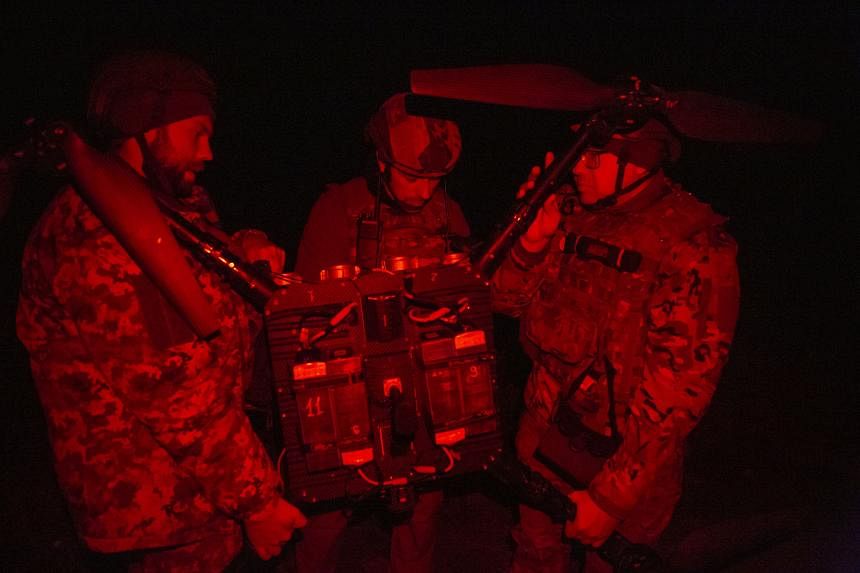KHERSON REGION, Ukraine - On the screen of a thermal imaging camera, the Russian armoured personnel carrier disappeared in a silent puff of smoke.
“What a beautiful explosion,” said First Lieutenant Serhiy, a Ukrainian drone pilot who watched as his weapon buzzed into a Russian-controlled village and picked off the armoured vehicle, a blast that was audible seconds later at his position about 6.4km away.
“We used to cheer, we used to shout, ‘Hurray!’ but we’re used to it now,” he added.
The war in Ukraine has been fought primarily through the air, with artillery, rockets, missiles and drones. And for months, Russia had the upper hand, able to lob munitions at Ukrainian cities, towns and military targets from positions well beyond the reach of Ukrainian weapons.
But in recent months, the tide has turned along the front lines in southern Ukraine. With powerful Western weapons and deadly homemade drones, Ukraine now has artillery superiority in the area – both in range and precision, commanders and military analysts say.
Ukrainian soldiers are taking out armoured vehicles worth millions of dollars with cheap homemade drones, as well as with more advanced drones and other weapons provided by the United States and allies.
The Russian military remains a formidable force, with cruise missiles, a sizable army and millions of rounds of artillery shells, albeit imprecise ones.
It has just completed a mobilisation effort that will add 300,000 troops to the battlefield, Russian commanders say, although many of those will be ill-trained and ill-equipped.
And President Vladimir Putin has made clear his determination to win the war at almost any cost.
Still, there is no mistaking the shifting fortunes on the southern front.
The new capabilities were on display in the predawn hours of Saturday when Ukrainian drones hit a Russian vessel docked in the Black Sea Fleet’s home port of Sevastopol, deep in the occupied territory of Crimea, once thought an impregnable bastion.
In the Donetsk region of eastern Ukraine, Russia fired roughly 10 artillery rounds for each answering shell from Ukrainian batteries.
In the strategic port city of Kherson, Ukrainian commanders say the sides are firing about equal numbers of shells, but Ukraine’s strikes are not only longer range but also more precise because of the satellite-guided rockets and artillery rounds provided by the West.

“We can reach them and they cannot reach us,” said Major Oleksandr, commander of an artillery battery on the Kherson front, whom like others interviewed gave only his first name for security reasons. “They don’t have these weapons.”
US-provided M777 howitzers firing precision-guided shells and striking up to 32km behind Russian lines have forced the Russians to stage heavy equipment farther from the front.
Ukrainian drones spot infantry but fewer tanks or armoured vehicles near the front line, said First Lieutenant Oleh, the commander of a unit flying reconnaissance drones.
This firepower has tipped the balance in the south, raising expectations that a long-anticipated assault on Kherson is drawing near – although a swirl of apparent misdirection from military leaders on both sides has clouded the picture.
The question remains just how long the Russian forces can, or will, hold out in Kherson.
“Russia is unable to maintain logistics supplies” to the west bank of the Dnipro River, said Mr Konrad Muzyka, a military analyst and director of Rochan Consulting, based in Gdansk, Poland.
He added that the Ukrainian military’s claim to have achieved the upper hand in artillery and front-line drone strikes in the south was “highly plausible”.
After a recent Ukrainian assault using American M777 howitzers and high mobility artillery rockets, Slovak Zuzana self-propelled artillery and Polish Krab self-propelled artillery, heavily battered Russian artillery positions on one section of the Kherson front went silent for more than 48 hours, Mr Muzyka said, citing Ukrainian military sources.
A recent drone attack led by Lt Serhiy provided another example of the Russian forces’ vulnerabilities.
Equipped with night-vision goggles – an essential item of modern warfare that the Russian forces generally lack – Ukrainian soldiers drove to the front line in a sport utility vehicle with the headlights off, passing the jagged ruins of houses in a destroyed village.
Rattling under the driver’s seat were eight small bombs, each packed with about 680g of high explosives, enough to obliterate an armoured vehicle. In the rear storage area sat a high-end, commercially available drone.
From a rooftop position, two former computer programmers turned tank hunters directed drone strikes that took out two Russian armoured vehicles in the space of about three hours, destroying more than US$1 million (S$1.41 million) of Russian weaponry with a weapon that cost about US$20,000.
Farther from the front line, out of drone range, US-provided, satellite-guided artillery shells have forced the Russian military to carefully camouflage or pull back heavy equipment, said Lt Oleh, the commander of a drone surveillance unit.

The partial destruction of bridges over the broad Dnipro River through the summer slowed Russia’s movement of heavy equipment to the river’s western bank, even as Western weaponry helped Ukraine whittle away at what was already there.
While the messaging and movement of forces around Kherson on both sides have been hard to decipher, by design, there is no mistaking which side has the momentum.
Maj Oleksandr, commander of the Ukrainian self-propelled howitzer battery, said he had the sense of the Russian lines that “if we shake them, they will disintegrate”.
But he was also aware of the possibility of deception, with the Russians trying to lure Ukraine into a premature advance by falsely signalling a willingness to withdraw.
Ukraine’s buildup of forces could also be a trick, he added. “The plans of our leadership are always unpredictable, and I like it that way.” NYTIMES

